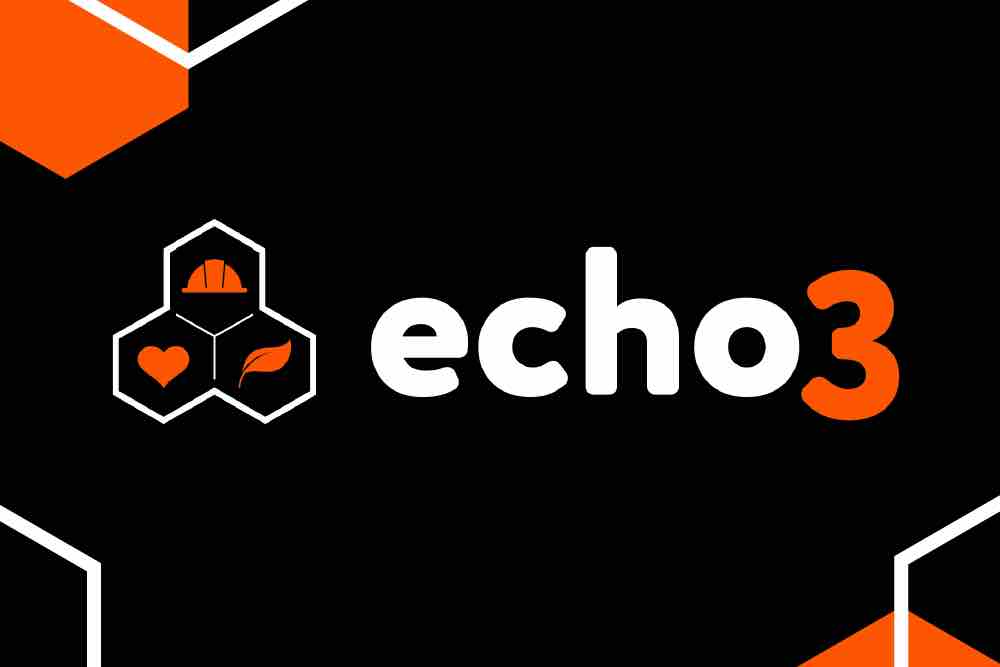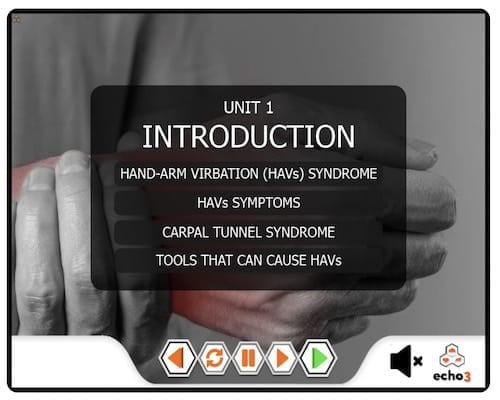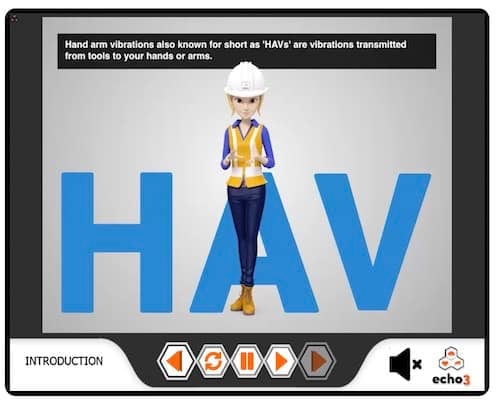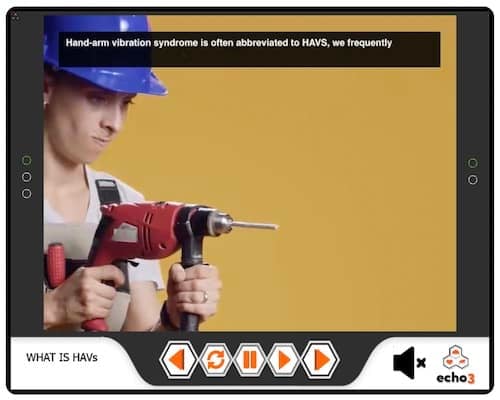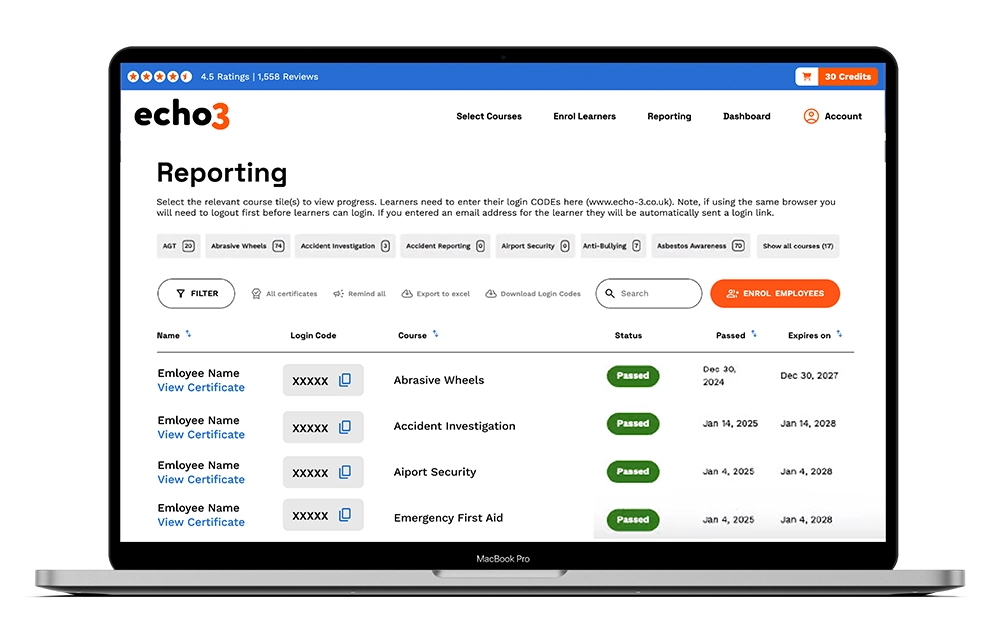HAVS Awareness Course
The Echo3 online Hand-arm Vibration course also known as HAVS Awareness training is fully accredited.
The term ‘Hand-arm vibration syndrome (HAVS)’ refers to the group of symptoms that can occur from using vibrating tools and equipment. These symptoms include, white finger, carpal tunnel syndrome, musculoskeletal injuries and vascular injuries.
Hand-arm vibration syndrome can be serious and, in the UK, nearly 2 million workers are at risk. Once the damage from HAVS is done it is permanent. By adopting the simple and cost-effective control measures outlined in this Echo3 course the risks can be avoided.
The cost of doing nothing about hand-arm vibration risks in the workplace can be high for both employees and employers. Providing appropriate training is also required by the Control of Vibrations at Work Regulations 2005.
HAVS Course Content
UNIT 1 – What is Hand Arm Vibration?
Participants gain an understanding of what HAVS is and the various symptoms it can cause including White Finger & Carpal Tunnel Syndrome. We also detail the tools the are likely to cause HAVS
UNIT 2 – Legal Duties
In this second unit we outline the legal duties of equipment manufacturers, employers and employees. This way staff know how to work in a compliant way. We also explain the Exposure Action Level and the Exposure Action Limit.
UNIT 3 – Risk Assessment
In the 3rd unit we detail the risk assessment process for HAVS and list a range of appropriate control measure that can be implemented to reduce the risk.
UNIT 4 – Protecting Yourself
In the 4th unit we outline how employees can keep themselves safe. This starts with first understanding their individual risk. Empowered with this knowledge staff are more likely to adhere to training and the best practices that are detailed.
Participants also learn how to identify HAVS symptoms and then acting appropriately. By reporting symptoms to their employer and contacting their doctor.
UNIT 5 – Quiz
The Hand Arm Vibration course culminates in a multi-choice quiz. Once participants have achieved 80%, they will be emailed their completion certificate.
HAVS Certificate
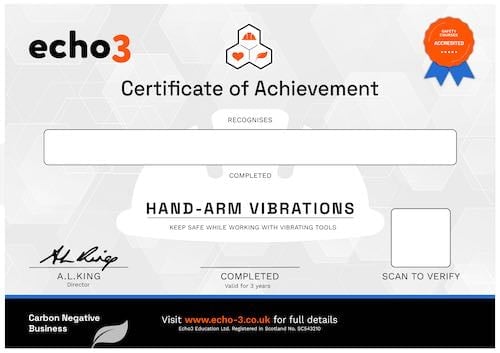
The Echo3 Hand Arm Vibration (HAVs) certificate is available to download by learners as soon as course has been successfully completed. PDF file format. If you have enrolled staff you can received their certificates by email. Or download from your admin dashboard.
- Successful completion requires achieving 80% in the final quiz
- Assessment conducted by 15 multi-choice questions
- Free unlimited retakes
- Certificate valid for 3 years
- Backup stored online
- Verify certificates by scanning the QR code.
- Posted version available separately HERE
As well as being emailed and available for download the Hand Arm Vibration certificate is stored online for employer records.
Course Preview
Echo3 courses include engaging motion-graphic video content, with full english subtitles
Reviews
How to Get Certified in 3 Steps
Individual Learners


Benefits for Individuals
-
Engaging video-based content
-
Learner dashboard included
-
Instant access after payment
-
Free course retakes
-
Shareable digital certificate
 QR Code Certificate
QR Code Certificate




Bulk Buying Discounts
What is HAVs?
The term ‘Hand-arm vibration syndrome’ refers to the group of symptoms that can occur from using vibrating tools and equipment. These symptoms include, white finger, carpal tunnel syndrome, musculoskeletal injuries and vascular injuries.
Examples of the equipment than can cause HAVS include, chainsaws, road breakers, hammer drills, hand-held grinders, jigsaws, polishers, powered lawn mowers and powered sanders.
Musculoskeletal injuries include bone cysts and osteoarthritis. These can cause chronic pain, impaired grip force and reduced mobility.
Vascular injuries due to HAV often cause the capillaries in the hand and fingers to constrict, restricting blood circulation. This can result in skin blanching, numbness, tingling and pain. As the condition worsens, the blanching can spread down the fingers, which is why this symptom is often referred to as ‘vibration white finger’. In severe cases, the reduced blood supply causes gangrene leading to the loss of fingers.
Neurological injuries are the result of damage to the nerves and senses, which can cause tingling or numbness in the hands or fingers. A Long-term injury that limits your ability to feel textures or temperatures and affects dexterity.
What are the objectives of HAVs training?
The HAVS Awareness training learning objectives include.
- Provide employees with an understanding of hand-arm vibration and the associated risks
- Learn about employer and employee legal obligations and how to comply with them
- Learn about the best practice measures employees should take to reduce the exposure to hand arm vibration
- Provide employers with an effective training solution to help reduce the risk from HAVS and comply with legislation.
Who should take HAVs training?
Employees who are exposed frequent use of vibrating equipment are at risk and require appropriate Hand Arm Vibration training that is proportional to the risk.
Employees in the following industries who are exposed to a HAVS risk will most likely benefit from this training.
- Construction
- Oil & Gas
- Road or railway maintenance
- Facilities or estate management
- Forestry
- Manufacturing
- Mining
- Motor vehicle manufacture and repair
- Public utilities
What are HAVs laws?
The Supply of Machinery (Safety) Regulations 2008 requires manufacturers to ensure that tools and equipment are designed to reduce vibration risk to as low a level as possible. They must also make use of the latest technology.
All equipment and tools must be CE-marked, and manufacturers must supply health and safety information. This should include risk warnings, information on safe use and maintenance, and a vibration emission statement.
Employers must comply with The Control of Vibration at Work Regulations 2005.
These regulations require that risk is assessed and managed, and that suitable clothing, equipment and training is provided. You should be informed of risks of exposure to vibration and your employer should check your health and make sure it is recorded. All cases of HAVS must also be reported.
Employees must follow instructions from your employer on safe working practices. This means you must comply with any directions or training given by your employer in the way tasks are carried out to ensure the vibration exposure is limited.
Employees should report anything that might affect the vibration exposure, such as faulty equipment, missing or damaged vibration controls or the wrong equipment being used.
Employees must also co-operate with their employers on any control measures that have been introduced.
What tools can cause HAVS?
There are hundreds of different types of hand-held power tools and equipment, which can cause ill health from vibration. Its important to use the correct tool for the job and maintain them appropriately.
Some of the more common ones are:
- Chainsaws
- Concrete breakers and road breakers
- Cut-off saws
- Hammer drills
- Hand-held grinders
- Impact wrenches
- Jigsaws
- Needle scalers
- Pedestal grinders
- Polishers
- Power hammers and chisels
- Powered lawn mowers
- Powered sanders
- Scabblers
- And, Strimmers or brush cutters.
What are the HAVs exposure limits?
The 2 terms to consider when thinking about Hand-arm vibrations and how much vibration staff are experiencing at work are the Exposure Action Value and Exposure Limit Value.
The daily exposure to vibration can be calculated by measuring the magnitude of the vibration against the duration of exposure to the vibration within an 8-hour day.
If daily exposure to vibration is within the Exposure Action Value area of the chart, employers must reduce the risk.
If the daily exposure is above the Exposure Limit Value, employers must then take immediate action to reduce your exposure to vibration.







